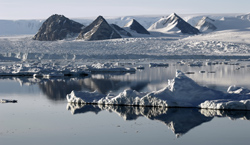Effect of Atlantic water on the Arctic Ocean
A key question arising from climate research in the Arctic was whether heat carried by oceanic currents can influence the formation of sea ice. A further question has been whether an increase in oceanic heat can reduce the level of ice cover. The ASOF-N project has investigated possible changes in the region as a result of climate change. Researchers studied the inflow of warmer water from the Atlantic Ocean into the Arctic Ocean. Scientists from ASOF-N also measured the outflow of sea ice and the export of freshwater from the Arctic Ocean to the Nordic Seas through Fram Strait. Fram Strait has a depth of 2600m and is the only deep passage connecting the Arctic Ocean to the rest of the world ocean. For this reason, researchers calculated the level of exchange of intermediate and deep waters occurring between the Arctic Ocean and the Nordic Seas. Measurements taken in Fram Strait indicated that pulses of warmer Atlantic water passed through the strait adding their heat to the Arctic Ocean. The Atlantic water also provides the main input of volume, salt and heat to the Arctic Ocean. This was ten times greater than the inflow of Pacific water through the Bering Strait. However, not all the water entering through the Fram Strait is from the Atlantic. It can also include intermediate and deep waters, or result from water being recirculated in, or just to the north of, the strait itself. The length of time that the circulating water resides in the ocean's different basins varies; heat entering the Arctic Ocean becomes dissipated over time and space. The water just north of the Fram Strait can take one year to circulate, while that passing through the remote Canada basin can take 20-30 years.

